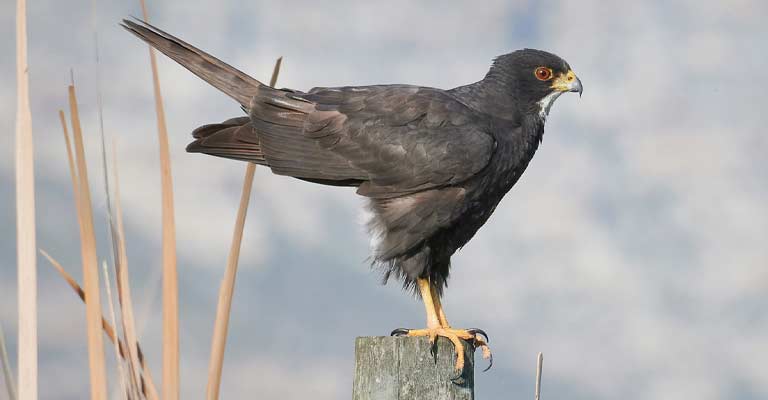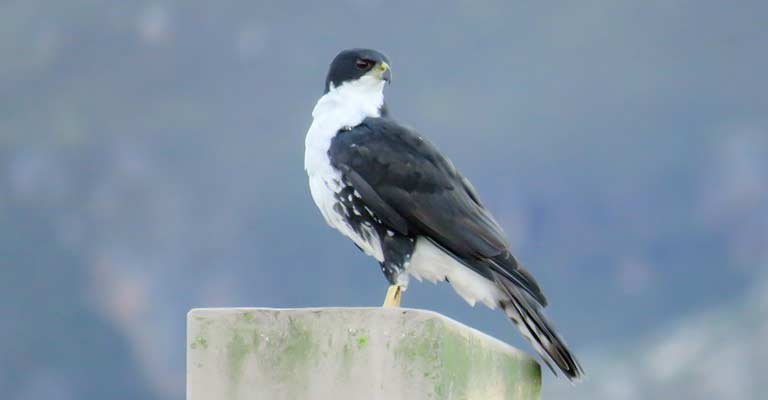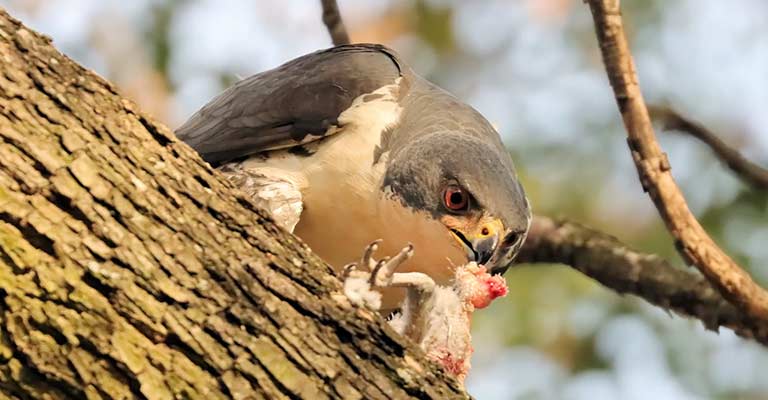The Black Sparrowhawk (Accipiter melanoleucus) stands as an iconic raptor, gracing the skies of sub-Saharan Africa with its commanding presence.
Characterized by a glossy black upper body and contrasting white underbelly, this medium-sized bird of prey captivates observers with its striking plumage and aerial prowess.
Known for adaptability, it thrives in various environments, from dense woodlands to urban landscapes, demonstrating a remarkable ecological resilience.
The species is renowned for its acrobatic flight patterns, navigating through dense vegetation in pursuit of avian prey.
A territorial breeder, the Black Sparrowhawk constructs large stick nests in tall trees, reflecting its commitment to successful reproduction.
Beyond its aesthetic allure, the Black Sparrowhawk’s life history unveils a narrative of adaptability, intricate behaviors, and ongoing conservation challenges that underscore the importance of safeguarding this majestic species in the African avian panorama. Stay focused.

Taxonomy of Black Sparrowhawk
Here is a table outlining the taxonomy details of the Black Sparrowhawk:
| Taxonomic Rank | Classification |
| Domain | Eukaryota |
| Kingdom | Animalia |
| Phylum | Chordata |
| Class | Aves |
| Order | Accipitriformes |
| Family | Accipitridae |
| Genus | Accipiter |
| Species | A. melanoleucus |
The two subspecies of the Black Sparrowhawk (Accipiter melanoleucus) identified as A. m. temminckii (Hartlaub, 1855) and A. m. melanoleucus (Smith, A, 1830) contribute to the fascinating diversity within this raptor species.
- A. m. temminckii (Hartlaub, 1855): This subspecies, named after the ornithologist Coenraad Jacob Temminck, exhibits distinctive characteristics within the Black Sparrowhawk population. The specific traits, such as plumage variations or regional adaptations, are often nuanced and reflect the intricacies of the species’ distribution.
- A. m. melanoleucus (Smith, A, 1830): Named by the renowned Scottish zoologist Andrew Smith, this subspecies showcases its own set of unique features. The nomenclature “melanoleucus” refers to the bird’s characteristic black and white coloration, emphasizing its striking appearance.
While the differences between these subspecies might be subtle to the casual observer, ornithologists and researchers scrutinize their distinct characteristics to gain insights into the evolutionary adaptations and geographic variations within the Black Sparrowhawk population.
Understanding the nuances of these subspecies contributes to a more comprehensive comprehension of the overall ecology and biology of this captivating bird of prey across its diverse range.
Identifying Characteristics of Black Sparrowhawk
The Black Sparrowhawk (Accipiter melanoleucus) is a striking bird of prey native to sub-Saharan Africa.
Recognizing this majestic raptor involves careful observation of its physical characteristics, behavior, and habitat. Here are eight key points to help identify the Black Sparrowhawk:
Size and Shape

The Black Sparrowhawk is a medium-sized raptor with a compact and robust build. It typically measures between 40-55 centimeters in length, and its wingspan ranges from 80-110 centimeters.
The bird displays a distinctive combination of long tail feathers and short, broad wings, giving it a uniquely agile and acrobatic flight pattern.
Coloration
As the name suggests, the Black Sparrowhawk exhibits predominantly dark plumage. Adults showcase a glossy black upper body with a contrasting white underbelly.
Juveniles, on the other hand, display a more mottled appearance with brown and white streaks, gradually transitioning into the adult coloration as they mature.
Facial Features

The bird’s face is characterized by a yellow or orange cere and legs, adding a vibrant splash of color to its otherwise dark appearance.
The eyes are large and yellow, providing excellent vision for hunting. The distinctive facial features contribute significantly to its identification.
Tail Bands

One of the most distinguishing features of the Black Sparrowhawk is the presence of several white bands on its tail feathers.
These bands are prominent and become particularly noticeable during flight, aiding in quick visual identification.
Habitat and Range
Understanding the habitat and range is crucial for identification. Black Sparrowhawks inhabit a variety of environments, ranging from forests and woodlands to urban areas.
They are commonly found in the sub-Saharan regions of Africa, with a distribution that extends from South Africa to Ethiopia.
Flight Pattern

Observing the bird’s flight pattern is another key element in identification. The Black Sparrowhawk is known for its swift and agile flight, often characterized by rapid wing beats interspersed with gliding.
Its ability to maneuver through dense vegetation sets it apart from other raptors.
Call and Vocalizations
Acoustic cues can be instrumental in identifying the Black Sparrowhawk. Their vocalizations include a series of high-pitched, piercing calls.
Familiarizing oneself with these distinctive sounds can aid birdwatchers in locating and recognizing this species.
Behavioral Traits

The Black Sparrowhawk exhibits certain behavioral traits that contribute to its identification. It is a skilled hunter, preying on birds and small mammals.
Observing its hunting techniques, such as sudden dives and rapid pursuit flights, can provide valuable clues for identification.
Recognizing the Black Sparrowhawk involves a holistic understanding of its physical attributes, habitat preferences, flight behavior, and vocalizations.
Aspiring birdwatchers should pay close attention to the interplay of these characteristics to confidently identify this captivating bird of prey in the African skies.
Black Sparrowhawk Life History
The Black Sparrowhawk (Accipiter melanoleucus) is a captivating bird of prey found in sub-Saharan Africa, known for its striking appearance and impressive hunting prowess.
Delving into the life history of this species provides a comprehensive understanding of its ecological role and the challenges it faces.
From its feeding habits to breeding behaviors and conservation concerns, each aspect contributes to the intricate tapestry of the Black Sparrowhawk’s existence.
Food

The diet of the Black Sparrowhawk primarily consists of birds, making it an avian predator of note.
Its hunting strategy involves swift and agile flight, enabling it to pursue and capture birds mid-air.
Pigeons, doves, and other medium-sized avians often find themselves on the menu, showcasing the Black Sparrowhawk’s adaptability in various environments.
Habitat
The Black Sparrowhawk exhibits a broad range of habitat preferences, displaying remarkable adaptability.
From dense forests and woodlands to urban areas, these raptors have successfully established themselves in a variety of landscapes.
This adaptability is a testament to their resourcefulness and ability to thrive in diverse ecosystems.
Range Map
The species’ distribution spans the sub-Saharan regions of Africa, covering a vast expanse from South Africa to Ethiopia.
A detailed range map aids researchers and conservationists in monitoring population trends and understanding the interconnectedness of various Black Sparrowhawk populations across the continent.
Nesting

Black Sparrowhawks are territorial birds, and nesting plays a crucial role in their life cycle. They build large stick nests in the canopy of tall trees, providing a secure haven for their offspring.
The choice of nesting sites varies, but the construction of these sturdy nests ensures the safety and stability required for successful reproduction.
Nesting Details of Black Sparrowhawk (Accipiter melanoleucus)
| Aspect | Details |
| Clutch Size | Typically 2 to 4 eggs |
| Number of Broods | Usually one brood per breeding season |
| Egg Length | Approximately 50 to 60 millimeters |
| Egg Width | Approximately 40 to 45 millimeters |
| Incubation Period | Around 35 to 38 days |
| Nestling Period | Approximately 35 to 42 days |
| Egg Description | Pale bluish or greenish-white with some markings |
| Nest Type | Large stick nest, often constructed in tall trees |
| Nest Placement | Positioned in the canopy, providing security |
| Parental Care | Both parents participate in incubation and feeding |
Understanding the nesting details of the Black Sparrowhawk provides valuable insights into its reproductive biology and behavior.
The species demonstrates a moderate clutch size, with parents engaging in collaborative care during the incubation and nestling periods.
The large stick nests, carefully placed in the treetops, contribute to the species’ breeding success and the overall conservation of this remarkable bird of prey in sub-Saharan Africa.
Breeding
Breeding season for Black Sparrowhawks typically occurs during the austral spring and summer months.
The courtship displays involve aerial acrobatics and vocalizations, reinforcing pair bonds.
Females lay a clutch of two to four eggs, and both parents participate in the incubation and care of the nestlings, fostering a collaborative approach to parenting.
Diseases
While Black Sparrowhawks are resilient, they are not immune to diseases. Avian diseases can impact their health and reproductive success.
Monitoring for signs of diseases, such as changes in behavior or plumage, is essential for early detection and intervention.
Treatment
Veterinary care and rehabilitation efforts are crucial for addressing diseases and injuries in Black Sparrowhawks.
Collaboration between wildlife veterinarians and conservation organizations is vital in developing treatment plans that ensure the health and well-being of individual birds, contributing to the overall conservation of the species.
Conservation
The Black Sparrowhawk faces various threats, including habitat loss, persecution, and pesticide exposure.
Conservation efforts aim to address these challenges through habitat preservation, public awareness, and research initiatives.
Engaging local communities and implementing sustainable practices are integral to the long-term conservation of this majestic raptor.
The life history of the Black Sparrowhawk is a testament to the species’ adaptability and resilience.
Understanding its feeding habits, habitat preferences, breeding behaviors, and the challenges it faces provides a foundation for informed conservation efforts, ensuring the continued survival of this remarkable bird of prey in the African landscape.
10 Amazing Facts About Black Sparrowhawk
The Black Sparrowhawk (Accipiter melanoleucus) stands as a captivating avian species native to the diverse landscapes of sub-Saharan Africa.
From its striking appearance to its remarkable behaviors, here are 10 amazing facts that showcase the uniqueness of this majestic bird of prey.
- Distinctive Plumage: The Black Sparrowhawk boasts glossy black plumage on its upper body, creating a striking visual contrast with its white underbelly. This unique coloration sets it apart in the avian world.
- Adaptable Habitat Range: Known for its adaptability, the Black Sparrowhawk thrives in various environments, ranging from dense forests and woodlands to urban areas. This adaptability contributes to its widespread distribution.
- Aerial Acrobatics: Renowned for its acrobatic flight, the Black Sparrowhawk exhibits agile maneuvers in pursuit of prey. Its ability to navigate through dense vegetation showcases the bird’s exceptional flying skills.
- Territorial Nesting Behavior: Black Sparrowhawks are territorial birds, establishing large stick nests in the canopy of tall trees. This behavior ensures a secure and stable environment for breeding and raising offspring.
- Impressive Courtship Displays: During the breeding season, Black Sparrowhawks engage in captivating courtship displays. Aerial acrobatics and vocalizations strengthen pair bonds, highlighting the species’ intricate social behaviors.
- Vocal Communication: The Black Sparrowhawk communicates through a series of high-pitched calls. These vocalizations serve various purposes, including mate attraction, territory defense, and communication between mates.
- Avian Predators: As skilled avian predators, Black Sparrowhawks primarily feed on birds, showcasing their prowess in mid-air hunting. Pigeons and doves are among their favored prey.
- Egg Appearance: The eggs of the Black Sparrowhawk are pale bluish or greenish-white with distinctive markings. The appearance of the eggs adds to the overall allure of the species’ reproductive biology.
- Parental Collaboration: Both male and female Black Sparrowhawks actively participate in incubating the eggs and caring for the nestlings. This collaborative parenting approach contributes to the species’ reproductive success.
- Conservation Concerns: Despite their adaptability, Black Sparrowhawks face conservation challenges, including habitat loss and human-related threats. Conservation efforts aim to address these issues and ensure the continued survival of this remarkable bird.
The Black Sparrowhawk’s combination of striking aesthetics, aerial prowess, and unique behaviors makes it a fascinating subject for bird enthusiasts and underscores the importance of conservation initiatives to safeguard this iconic species.
Wrapping Up
In the intricate tapestry of African ecosystems, the Black Sparrowhawk emerges as a captivating avian ambassador.
Its adaptability, striking appearance, and aerial prowess underscore the significance of understanding and conserving this remarkable bird.
From acrobatic flights to collaborative parenting, the Black Sparrowhawk stands as an exemplar of nature’s wonders, weaving its story into the fabric of sub-Saharan Africa’s biodiversity. Thank you so much.